Each One, Teach One to Plant One
Peepal / Raavi Chetlu/ Arasu Mara/ Arali Mara Ficus religiosa
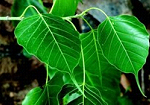
The Peepal tree is considered the most sacred of all trees in India.. It is a keystone species as it harbours large number of birds, insects and small arboreal animals. It is a very good species used for fuel, fodder and medicinal purposes. Bark of its root is one amongst the five most valued source of medicine by ancient Indian physicians.
Neem / Vepa Chetlu Azadirachta indica
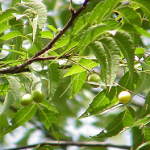
Neem is the State tree of Andhra Pradesh.It is one of the thrifty trees which have much less demand on soil fertility or moisture content. It is a highly useful, large evergreen tree, with matchless medicinal properties. The heartwood is hard, durable, and is used for various purposes. Bark and leaves are used in a large number of medicinal concoctions all over India. Seeds yield oil which has industrial uses. Neem cakes are used as fertilizer. Leaves are used as fodder.
Karanj / Kanuga/ Pungam Pongamia pinnata
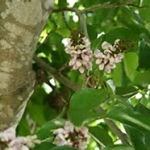
It is a multipurpose tree. It is a very useful tree in rural economy, being a source for an excellent fuelwood. It is also used for making rafters, carts, agricultural implements and veneers. Its leaves keep away termites, and make a coveted green manure. In Ayurveda, bark, leaf and seed of the tree are used as medicines many human ailments. The flowers exude peculiar fragrance, and are full of nectar. The seeds yield non-edible oil, used as an alternative to diesel.
Indian Rosewood Dalbergia latifolia
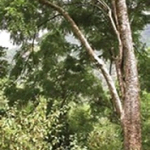
It is a large tree with straight, large bole and spreading branches. The dark-purple heartwood with black streaks is extremely hard and heavy. The stem yields a bitter tonic used in traditional systems of medicine. It is an ornamental tree suitable for planting in avenues, along roads, and in parks for shade. The seeds are edible.
Shisham/Sissoo Dalbergia sissoo
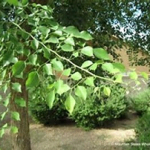
It is a fast growing multipurpose tree species. It is a valuable source of timber, being heavy, very strong, moderately tough, steady and very hard. It is used for high quality furniture and cabinet making, tool handles, door and window frames etc. The roots, leaves, bark and the heartwood are used to cure ailments like diarrhea, dysentery etc. The tree is generally planted along roadsides, on field boundaries, in shelter belts and on degraded lands.
Palash / Flame of the Forest/ Mothaka chetlu Butea monosperma
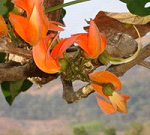
it is a medium sized deciduous tree which grows in open country. During summer (which is also spring time in India) this tree produces clusters of blood-red flowers in great profusion. Bereft of leaves at that time, Palash’s fiery orange flowers dazzle the forest scene, and hence the name Flame of the Forest. In Ayurveda, its bark, flower and resin are used.
Saptaparni Alstonia scholaris
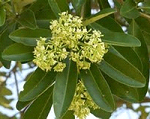
It is a grand, large evergreen tree that is extremely tolerant of pollution. Its bark yields a bitter drug (ditabark), used to treat a range of complaints from chronic diarrhoea, dysentery and asthma to fevers. People in coastal areas of India use the decoction of the bark as an insurance against malaria. Its milky latex is also used to treat sores, ulcers etc. The greenish white flowers appearing in long pendulous follicles, in clusters are highly fragrant. The wood is soft, light and fine-textured. It seasons poorly and is not very durable. It is sometimes used to make minor furniture, tea chests etc. It is also used for plywood and second class match splints.
Alexandrian Laurel Calophyllum inophyllum
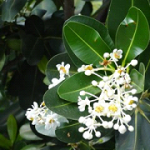
This is a very elegant evergreen tree with shining leaves.The tree is cultivated for its ornamental value and for shade in many parts of India. The reddish brown timber is fairly hard and durable under water. It is useful in building ships, fishing boats, for making furniture; and also for construction purposes. Almost all parts of this tree are medicinal, used to cure a range of ailments. Its root is used for treating ulcers; its resin is used as a purgative and emetic. A decoction of flowers is given to cure eczema and insanity. In Ayurveda, bark and seed oil is used in rheumatoid arthritis, skin diseases, dysentery, diarrhea, hemorrhage and dysuria. Seeds yield oil, used in soap making and as lubricant.
The Tree of Heaven Ailanthus excelsa
This is a fast growing large deciduous tree. In peak summer, when everything appears dull and drab in the shades of brown and grey, Ailanthus excelsa is one of the few trees that stand apart with lush green leaves, defying the blazing sun. The soft, white and lustrous wood is used for packing cases, and the debarked wood is used in paper industry as a substitute for aspen (Poplar spp.), for printing papers. It is extensively used for making matchwood boxes, match splints, and in cottage industries for making wooden toys. Leaves are rich in protein and are used as a valuable fodder. The bitter, astringent bark is used in traditional medicine.
Ashoka/ Sorrowless Tree: Saraca asoca
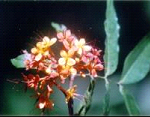
Ashoka is one of the prettiest trees of India. It is a sacred tree for the Hindus, the Buddhists and the Jains. It is a small sized tree, growing up to 6 m to 9 m height. It has spreading branches which form a dense canopy and a shapely crown. Young leaves of this tree are beautiful, appear to be made of copper. This tree gets flush of new leaves quite regularly and quite often. Flowers are borne directly on stem and at the tip of branch. The orange-yellow flowers which turn vermillion in a dense formation, also have a delicate fragrance that is felt and enjoyed more during the night than in the day. Flowers of this tree are pounded inside water and used to cure dysentery. Dried flowers are used in treating diabetes. Pods are reported to make very good forage for cattle. Bark of this tree is widely used in Ayurveda and folk medicine systems from time immemorial, especially in treating ailments concerning women, like menstrual complaints, uterine hemorrhage etc. Leaves are used to treat bleeding of piles and skin diseases. Bark and dried flowers are medicinal and are highly useful in uterine disorders. The well- known Ayurvedic preparations from it are” Ashokarishta” and “Ashokaghrita”.
Champaka / Sampangi/ Sampige Magnolia champaca
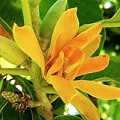
Champaka is a contribution from the Oriental realm, and grows in moist and wet forests of the Western Ghats and North East India. Though this tall handsome evergreen tree also yields valuable timber, it is seldom cut as it is considered sacred. It is commonly cultivated in the neighborhood of temples for its yellow and sweetly scented flowers. Flowers are used for medicinal purposes and the attar extracted is used in perfume industry. Yellow dye extracted from flowers is used for colouring foodstuff. Various parts of the tree find place in traditional medicines.
Bakula/ Indian Medlar Mimusops elengi
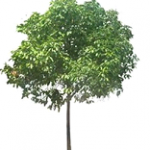
This is a large elegant evergreen tree with a straight trunk. This tree yields a hard and durable wood, used for making furniture, carts, boards etc. The star shaped flowers of this tree are pale-white, fragrant. They are shed during the night, and in the morning one can find the ground beneath the tree covered with flowers. For this reason, Bakula is often planted on the sides of sacred groves. The greatest virtue of the flower is that it retains its sweet scent even when dry. Fruit is a berry with a single seed and is edible. Fruits, flowers and leaves of the tree are used as medicine. In Ayurveda, its bark, flower and fruit are used for curing leprosy, uterine disorders, cardiac diseases, eye diseases, etc.
Paarijaath/ Night Jasmine Nyctanthes arbortristis
It is a small tree that grows all along the foothills of Himalayan tract and the Peninsular India. This deciduous tree has simple dull green foliage. It is an excellent fuel wood. Leaves are used in traditional medicine. It is held sacred and is generally grown in temples. It blooms in the evening and its flowers fall off soon after. Flowers are beautiful, and the scent of its flowers is exhilarating.
Indian Tulip Poovarasu Thespesia populnea
It is a medium sized fast growing evergreen tree, commonly found in South India. It is a thrifty tree, growing along saline coasts to arid interior India. Because of its large rounded crown, this shade giving tree is sometimes called ‘umbrella tree’. Its large leaves are used for packing edible items. Its bark, leaves, flowers, fruits and roots are used in local medicines. Bark also yields good fibre. Its wood is hard, durable and water resistant, used in making cartwheels, boats, furniture, and gun stocks. Root, fruits and leaves are used in curing scabies, psoriasis and other cutaneous diseases. Bark is astringent and anti-dysenteric. The brilliant yellow flowers of this tree are splendid, large and showy, with a purple eye at the centre turning pink as the flowers age. This tree flowers almost throughout the year, but chiefly during cold weather. Honey bees swarm its flowers for nectar.
Indian Laburnum Cassia fistula
As this tree has the softest cascade of yellow flowers drooping from every branch, it is also known as Golden Shower. Its light green buds at the tips and light green stalks highlight the beauty of the flowers. These flowers last long and when ultimately they are about to wither away, its long light green leaves reappear. Thus the whole tree is either draped in lush green leaves or covered with bright yellow flowers, and as a result, it always remains a highly decorative tree. The Hindus use the flowers in religious ceremonies. Its wood is hard and durable, used in making agricultural implements, posts and beams of buildings, etc. Fruit pulp is a purgative. A decoction made from roots is used in curing stomach ailment. Bark of this tree is used in tanning hides, dyeing leather and jute fibres.
Pride of India / Queen’s Flower Lagerstroemia flos-reginae
It is a fast growing large deciduous tree with spreading branches. Its purplish blooms are strikingly beautiful, giving it the name ‘Pride of India’. Profuse flowering occurs a little late in the summer (May – June), and covers the entire tree. This tree yields valuable timber. As its wood is hard, strong, and durable under water; it is used in India for making boats, canoes, carts, ammunition boxes, and also in buildings. Seeds are narcotic. In Ayurveda, bark, leaf, fruit and seed are extensively used to cure a number of ailments including diabetes. Leaves, bark, dried fruits and roots are also used in other indigenous systems of medicine. Tannin can be extracted from fruits and leaves.
Wood Apple Limonia acidissima L.
It is a medium sized deciduous tree commonly found throughout the drier parts of the Peninsular India. The light brown wood of this tree is used in construction and in the making agricultural implements. Its fruit pulp is much valued as a food and also as medicine. It is eaten plain or made into a sherbet, or preserved as jam. This tree is often cultivated in rural areas for its fruits.
Kachnar / Camel foot Tree Bauhinia variegata
It is a medium sized, deciduous, fast growing tree. With large showy, orchid- like flowers which are full of fragrance, it is popularly known as ‘Orchid Tree’. These flowers are also edible. Leaves of this tree are used as beedi wrappers. Seeds yield oil. Timber is hard and used in making agricultural implements. Bark of this tree is used in tanning and dying. It is also medicinal. It is a good fodder tree and withstands heavy lopping.
Mahua Madhuca longifolia
It is a medium sized deciduous tree with spreading branches and a rounded crown. It is found in many parts of deciduous forests in India. For many tribal groups in Central India, ‘Mahua’ flowers are a major source of food. Sugar is extracted from its flowers. Flowers are also used to distill a potent and popular liquor. Fruits are eaten afresh or dried; its outer coat is cooked as a vegetable. A thick oil is extracted from its kernel; hence the name ‘Butter Tree’. This tree has medicinal uses. In Ayurveda, flower and seed oil are used for curing oedema, leprosy, polyuria, diarrhea, and gout. Bark is used in treating stomach ache of horses and bone fracture of cattle. Oil cakes from this tree is a good manure and when spread on lawn, eradicate worms.
Malabar Neem/ Melia dubia
It is one of the fastest growing timber trees of tropical India, attaining great height with a spreading crown. Fodder from this tree is relished by cattle, goats and sheep. The wood is used in making packing cases, ceiling planks, match box and musical instruments and catamarans. Apart from being an excellent source of commercial plywood, it is a good species for agro-forestry purposes.
Kadamba Anthocephalus cadamba
It is a tall, straight-boled, deciduous tree with whorled, horizontally spreading branches. Though it is basically a riparian species, Its wood is used in making dugouts, ply wood, packing cases paper etc. Its bark has medicinal value and leaves are fed to cattle. It is a much valued ornamental tree for its fragrant yellow-orange flowers. Bark of this tree is a febrifuge and tonic while its fruit is considered an aphrodisiac. An essential oil is extracted from the flowers. Fruits are distilled to make wine and vinegar. It is planted near houses, temples, sacred places, in gardens and park and along avenues.
Arjuna Terminalia arjuna
Arjuna is a large handsome tree of tropical and subtropical forests, naturally occurring along the banks of rivers, streams, ravines and dry watercourses. This tree is exceptionally beautiful with its often buttressed stem, smooth bark, horizontal branches and drooping branchlets. Arjuna’s wood is hard and strong; indeed is harder than Teak, and stronger too. It is used in making boats, ships, carts, posts, beams, agricultural implements, furniture and cabinets. Its bark yields a number of Ayurvedic medicines. It has been used in the treatment for heart diseases by the Hindu Physicians of yore and its curative properties have been fully supported even by modern investigations. Bark is very much used for tanning purposes too, besides being a potential source of oxalic acid, an important ingredient in pharmaceutical and textile industries. A transparent brownish/golden coloured gum is obtained from the bark of this tree, which is edible, and very nutritive. It is also used as an adhesive. Silkworms that produce tassar silk feed on the leaves of this tree. Its fragrant flowers of are dull yellow in colour, and contain nectar in good proportion.
Bahara Termnalia bellirica
It is a large deciduous tree, buttressed at the base, found in most parts of plains and low hills of India, barring very moist and desert areas. Wood of this tree is hard. Though not durable, it is used as a timber in certain parts of India, but avoided for religious reasons in most parts. Bark of this tree is used in anaemia, leucoderma etc. Its fruit is well known as ‘myrobolan’, used in treatments for diseases of eyes, nose heart and bladder.
Haritaki Terminalia chebula
It is a multipurpose medicinal tree. Bark of this tree is diuretic, and cardio tonic. Fruits are laxative and used for treating wounds, ulcers, inflammation etc. Natural regeneration of this species is abysmally low in most forests as both raw and ripe fruits are harvested from trees. Such dysgenic extraction has endangered this species.
Bilwa: Golden Apple Tree Aegle marmelos
This medium sized (10 to 12 m tall) sacred tree is common in India, occurring in sub–Himalayan tracts, Central and South India. In the peninsular India it is restricted to the dry and moist deciduous forests of the Eastern and Western Ghats. The wood of Bilwa is hard, with a strong aromatic scent when freshly cut. Its greenish-white flowers are wonderfully fragrant. Its fruits, when ripe contain reddish–orange pulp, which is rich in mucilage. A large number of hairy seeds, up to 1 cm in length are embedded in the pulp. Almost every part of this tree has medicinal properties, used in different systems of treatment, especially in Ayurveda, Unani, and in home remedies. The pulp of Bilwa fruit is astringent, and is consumed as ‘sherbet’ (sweetened drink). It is believed that this fruit pulp increases the lifespan. It is believed to be good for the skin and vision too. Root bark is reported to be useful in cardiac diseases. Unfortunately, despite its usefulness, and despite it being a sacred plant, Bilwa has become one of the endangered trees of India.
Putranjiva/Indian Amulet Tree Drypetes roxburghii
It is a medium sized graceful evergreen tree with dense foliage, and low spreading, drooping branches. It is a sacred tree, commonly found cultivated for its medicinal value. Its wood is shining, fairly hard and close grained. It is used for turning, making tools and for structural works. Leaves and seeds are used in making medicine for curing cold and cough. Leaves of this tree are a good fodder, and its seeds yield oil which is sometime used for burning. Seeds are strung in necklaces and rosaries.
Kokko / East Indian Walnut Albizzia lebbeck
It is one of the most promising trees of India.iDgestibility of its leaves and tender twigs for cattle is considerably higher than that of most other fodder trees. It is also an excellent fuel wood species and a source for charcoal. Its wood is suitable for construction, furniture and veneer. Gum from the tree is valued.
Kejri Prosopis cineraria
It is an extremely drought tolerant species. This tree produces leaves in extremely dry summer months where most other trees remain leafless. Its leaves provide an excellent, nutritious fodder. Kejri pods contain a dry sweet pulp, which is also a source of good fodder. Green pods called ‘sangar’ are boiled and dried for human consumption. Its flowers are valuable for honey production. This tree yields an edible gum. Its bark and flowers are used for medicinal purposes too. Wood is used for making agricultural implements, in buildings etc. It is also an excellent source of fuel wood.
Chandan Santalum album
The close grained heartwood of this tree is strongly scented and used for carving. A highly priced essential oil is obtained from its aromatic heartwood and roots, used in perfumery and medicine. In Ayurveda, heart wood and oil are used to treat fever, polyuria, poisoning, debility and dysuria etc. It is an ingredient of “Chandanadi Bati”,”Chandanadi Churna” and ‘Chandanasava’. Heart wood is also used as an unguent in religious ceremonies. Sandal wood is the costliest timber in India, with a price tag of around Rs.7,000 per kg in current market rate. Heartwood of Sandal on steam distillation yields 2.5-6.2 per cent fragrant Sandal oil of high perfumery value. Currently Sandal oil is sold in the market at the rate of Rs.70,000-100,000 per kg.
Red Sanders / Yerra chandan / Rakta Chandan Pterocarpus santalinus
This endemic and endangered tree grows on dry hilly and rocky terrain at elevations of 150-900 m. The timber is hard, refractory, durable and heavily impregnated with red dye. This dark claret wood is used for carving, and as a source for edible dye. Paste made out of its heartwood is used in worship; for cosmetic purpose, and also for treating intrinsic hemorrhage, fracture, chronic fever etc. Leaves are considered to be a good fodder, but it may not be a wise use of this valuable species for this purpose. Its large yellow flowers offer pollen and nectar to the honey bees.
Gamhar / Shivane Gmelina arborea
Multiplicity of its uses and fast growing nature of this species receive great appreciation within Forest Departments as well as among growers who take up large scale plantations of this species. Its lustrous and smooth wood is used mainly for light construction works and for pulp. Several parts of this tree are used for medicine. Leaves are used as fodder. Root is extensively used in Ayurveda.
